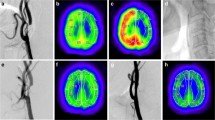Abstract
Background
Even after the recent randomized clinical trials JET and COSS, it is still unclear that impaired cerebrovascular reactivity (CVR) to acetazolamide and oxygen extraction fraction (OEF) can identify the candidates for superficial temporal artery to middle cerebral artery (STA-MCA) anastomosis. This prospective study was aimed to evaluate the benefits of STA-MCA “double” anastomosis on long-term outcome in patients with reduced cerebral blood flow (CBF) and CVR (Type 3 ischemia) and elevated OEF attributable to occlusive carotid diseases.
Methods
This study included 49 patients with reduced CBF and CVR on SPECT in the ipsilateral MCA area. Using 15O-gas PET, OEF was also measured in all patients. STA-MCA double anastomosis was recommended to the patients with Type 3 and elevated OEF. Those with Type 3 but normal OEF were medically treated.
Results
Of 36 patients with Type 3 and elevated OEF, 25 consented to surgery. No perioperative morbidity or mortality were noted. The other 11 patients with Type 3 and elevated OEF were medically treated. Annual incidence of ipsilateral stroke was 0.7 % and 6.5 % in surgically and medically treated patients with Type 3 and elevated OEF, respectively (P = 0.0188). None of patients with Type 3 but normal OEF developed ipsilateral stroke during follow-up periods. STA-MCA “double” anastomosis significantly decreased OEF.
Conclusions
STA-MCA “double” anastomosis may still have the potential to reduce the risk of recurrent ipsilateral stroke in hemodynamically compromised patients. Further studies would be essential to advance diagnosis, surgical procedures, and perioperative managements to bring out maximal effects of bypass surgery.


Similar content being viewed by others
References
Amin-Hanjani S, Barker FG 2nd, Charbel FT, Connolly ES Jr, Morcos JJ, Thompson BG (2012) Extracranial-intracranial bypass for stroke-is this the end of the line or a bump in the road? Neurosurgery 71:557–561
Chida K, Ogasawara K, Kuroda H, Aso K, Kobayashi M, Fujiwara S, Yoshida K, Terasaki K, Ogawa A (2011) Central benzodiazepine receptor binding potential and CBF images on SPECT correlate with oxygen extraction fraction images on PET in the cerebral cortex with unilateral major cerebral artery occlusive disease. J Nucl Med 52:511–518
Derdeyn CP, Yundt KD, Videen TO, Carpenter DA, Grubb RL Jr, Powers WJ (1998) Increased oxygen extraction fraction is associated with prior ischemic events in patients with carotid occlusion. Stroke 29:754–758
Duckworth EA, Rao VY, Patel AJ (2013) Double barrel bypass for cerebral ischemia: technique, rationale, and preliminary experience with 10 consecutive cases. Neurosurgery 73(1 Suppl Operative):ons30–38
Grubb RL Jr, Derdeyn CP, Fritsch SM, Carpenter DA, Yundt KD, Videen TO, Spitznagel EL, Powers WJ (1998) Importance of hemodynamic factors in the prognosis of symptomatic carotid occlusion. JAMA 280:1055–1060
Grubb RL Jr, Powers WJ, Clarke WR, Videen TO, Adams HP Jr, Derdeyn CP (2013) Surgical results of the carotid occlusion surgery study. J Neurosurg 118:25–33
Hokari M, Kuroda S, Shiga T, Nakayama N, Tamaki N, Iwasaki Y (2008) Combination of a mean transit time measurement with an acetazolamide test increases predictive power to identify elevated oxygen extraction fraction in occlusive carotid artery diseases. J Nucl Med 49:1922–1927
Hokari M, Kuroda S, Shiga T, Nakayama N, Tamaki N, Iwasaki Y (2008) Impact of oxygen extraction fraction on long-term prognosis in patients with reduced blood flow and vasoreactivity because of occlusive carotid artery disease. Surg Neurol 71:532–539
Kuroda S, Houkin K, Kamiyama H, Mitsumori K, Iwasaki Y, Abe H (2001) Long-term prognosis of medically treated patients with internal carotid or middle cerebral artery occlusion: can acetazolamide test predict it? Stroke 32:2110–2116
Kuroda S, Shiga T, Houkin K, Ishikawa T, Katoh C, Tamaki N, Iwasaki Y (2006) Cerebral oxygen metabolism and neuronal integrity in patients with impaired vasoreactivity attributable to occlusive carotid artery disease. Stroke 37:393–398
Kuroda S, Shiga T, Ishikawa T, Houkin K, Narita T, Katoh C, Tamaki N, Iwasaki Y (2004) Reduced blood flow and preserved vasoreactivity characterize oxygen hypometabolism due to incomplete infarction in occlusive carotid artery diseases. J Nucl Med 45:943–949
Nemoto EM, Yonas H, Kuwabara H, Pindzola RR, Sashin D, Meltzer CC, Price JC, Chang Y, Johnson DW (2004) Identification of hemodynamic compromise by cerebrovascular reserve and oxygen extraction fraction in occlusive vascular disease. J Cereb Blood Flow Metab 24:1081–1089
Ogasawara K, Ogawa A (2006) Japanese EC-IC bypass trial. Nippon Rinsho 64(7):524–527
Ogasawara K, Ogawa A, Yoshimoto T (2002) Cerebrovascular reactivity to acetazolamide and outcome in patients with symptomatic internal carotid or middle cerebral artery occlusion: a xenon-133 single-photon emission computed tomography study. Stroke 33:1857–1862
Powers WJ (1991) Cerebral hemodynamics in ischemic cerebrovascular disease. Ann Neurol 29:231–240
Powers WJ, Clarke WR, Adams HP Jr, Derdeyn CP, Grubb RL Jr (2012) Commentary: extracranial-intracranial bypass for stroke in 2012: response to the critique of the carotid occlusion surgery study “It was deja vu all over again”. Neurosurgery 71:E772–E776
Powers WJ, Clarke WR, Grubb RL Jr, Videen TO, Adams HP Jr, Derdeyn CP (2011) Extracranial-intracranial bypass surgery for stroke prevention in hemodynamic cerebral ischemia: the Carotid Occlusion Surgery Study randomized trial. JAMA 306:1983–1992
Rodriguez-Hernandez A, Josephson SA, Lawton MT (2012) Bypass surgery for the prevention of ischemic stroke: current indications and techniques. Neurocir (Astur) 23:5–14
Yamauchi H, Fukuyama H, Nagahama Y, Nabatame H, Ueno M, Nishizawa S, Konishi J, Shio H (1999) Significance of increased oxygen extraction fraction in five-year prognosis of major cerebral arterial occlusive diseases. J Nucl Med 40:1992–1998
Yamauchi H, Okazawa H, Kishibe Y, Sugimoto K, Takahashi M (2004) Oxygen extraction fraction and acetazolamide reactivity in symptomatic carotid artery disease. J Neurol Neurosurg Psychiatry 75:33–37
Conflicts of interest
None.
Disclosure of funding
None.
Financial support and industry affiliations
None.
Author information
Authors and Affiliations
Corresponding author
Rights and permissions
About this article
Cite this article
Kuroda, S., Kawabori, M., Hirata, K. et al. Clinical significance of STA-MCA double anastomosis for hemodynamic compromise in post-JET/COSS era. Acta Neurochir 156, 77–83 (2014). https://doi.org/10.1007/s00701-013-1961-0
Received:
Accepted:
Published:
Issue Date:
DOI: https://doi.org/10.1007/s00701-013-1961-0




